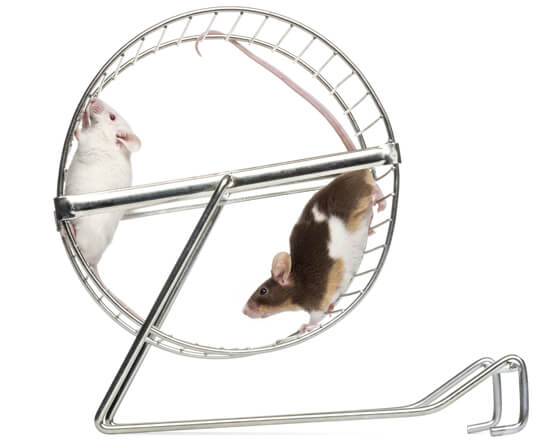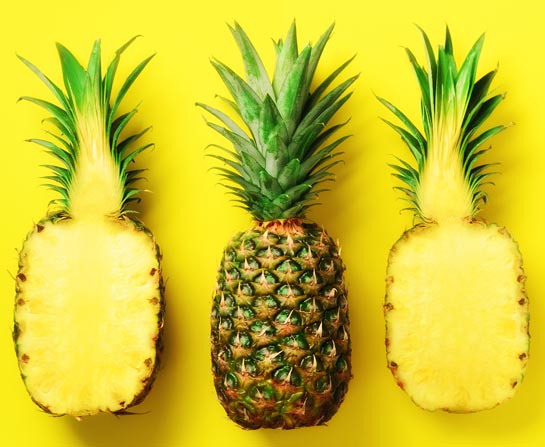WORDS PANK JIT SIN
Pineapples (Ananas comosus) are as synonymous with the tropics as coconuts are. Thanks to our classic movies such as Hawaii Five-O and Fantasy Island, the fruit is always seen as a must have in tropical settings. It can be bewildering to think how our ancestors decided to eat the fruit. Similar to the durian, it has spines and ‘eyes’ which are hard to remove. Our older folk may remember being forced by their parents to manually peel and remove the eyes in a spiral cutting motion. Nowadays, we can get them pre-cut at lunch places and supermarkets. As well as being delicious, pineapples contain a long list of nutrients and enzymes which are healthy for us.
shutterstock_2579274…
What is a pineapple?
Well, guess what? The pineapple, as you may already know, isn’t related to the pine nor the apple. It is actually a type of bromeliad. Bromeliads are plants with thick waxy leaves that spread out in a bowl-like fashion and catch rainwater at the centre. They produce beautiful flowers that last a long time. The pineapple first took the leap into worldwide fame when Christopher Columbus brought the plant to Spain when he returned from the New World in 1493.
Nutrition-wise, the fruit may not be ranked as a ‘superfood’ by today’s standards but the utility of pineapple lies in its enzymes. Take a look at what a typical 100-g portion of pineapple contains. (Table 1)
The main component that contributes to the sweetness of pineapples is sucrose while the main acid component is citric and ascorbic acids.2 The table does not list vitamins, of which pineapple has loads of. It has vitamin C (in the form of ascorbic acid), thiamin, riboflavin, niacin, pyridoxine, cobalamin, vitamin A, folate, and trace amounts of vitamin E.1
Table 1: Nutrition Facts— fight off oxidative stress.”Pineapple, raw, all varieties.
| Serving Size: 100 g | |
| Nutrient | Value |
| Water [g] | 86 |
| Energy [kcal] | 50 |
| Protein [g] | 0.54 |
| Total lipid (fat) [g] | 0.12 |
| Carbohydrate, by difference [g] | 13.12 |
| Fibre, total dietary [g] | 1.4 |
| Sugars, total [g] | 9.85 |
| Calcium, Ca [mg] | 13 |
| Iron, Fe [mg] | 0.29 |
| Magnesium, Mg [mg] | 12 |
| Phosphorus, P [mg] | 8 |
| Potassium, K [mg] | 109 |
| Sodium, Na [mg] | 1 |
Antioxidants
Pineapples contain a lot of flavonoids, which help the body fight off oxidative stress. Vitamin C, another potent antioxidant and immune booster, is helpful in reducing the duration of illness by stimulating the immune system.3
Enzymes
Bromelain, a protein dissolving enzyme, is found mostly at the centre of the pineapple fruit. It is the same enzyme responsible for the itchy tongue and lips some people face when eating pineapples. The enzymes attack the skin in our tongue, cheek and lips thus causing it to hurt. Some sensitive folk may even develop ulcers. There’s really no way to avoid the enzymes if you want to eat fresh pineapple. Preserved pineapples, on the other hand, won’t have that effect as it has to be heated before being canned. The heating process destroys all the enzymes. Some people suggest soaking the pineapple in salt water to reduce the itchy effect. It is doubtful that salt does anything to the enzyme; instead, it is probably the water dissolving the enzymes and flushing it away. But don’t forget, you’re also flushing the water-soluble nutrients away.
Are you allergic to pineapple?
One thing to watch out for is genuine pineapple allergy. Some may mistake the pain and itching from pineapple as a reaction to the bromelain when in effect it could be allergy to the fruit.
Allergic reactions are usually more severe compared to normal reactions. You may have swelling or other symptoms such as sneezing or difficulty in breathing. If that happens, drop the pineapple and head to your nearest clinic.
Due to the bromelain and other enzymes, pineapples are a great aid for digestion. Many digestive enzyme tablets contain bromelain as one of the key components to help in reducing discomfort and bloating after meals.
Fibre
Some pineapples may be fibrous if left to ripen for too long. Organic and vegan consumers are also resorting to fabric made from pineapple fibre. The source of the fibre comes from the entire plant, from the crown, leaf, stem, and even the fruit itself.4
Every 100 g of pineapple contains about 1.4 g of dietary fibre. This is by no means a large amount of fibre, so any improvement in bowel habit is due to the enzymes and juices of the fruit. The combined action of digestive enzymes and fibre in pineapple helps food to be properly digested as it travels through the gut.
Can I plant my own pineapples?
Unless you have a lot of space and patience, planting your own pineapple may be an exercise in futility. For one, it takes anywhere from 9 months to 2 years to mature, and only then will it flower and fruit.5 From the flower, a single fruit forms and this fruit takes about 6 months to grow to maturity. As the fruit juts out, birds, squirrels and bats will be eyeing it even before it fully ripens.
One good thing about the pineapple is that it is extremely hardy and even novice gardeners can’t really kill it. Belonging to the bromeliad family, the pineapple can absorb water through its leaves. It can also survive in a small pot as the root system is small and weak (because the leaves do a good job in sucking up water and preventing water loss). They do well with foliar fertilizers. One thing to watch out for when it comes to plants in the bromeliad group is their tendency to store water at the centre of the plant during the raining season. If you have only a few plants, then it may be worth checking them out periodically and pouring any excess water stored at its centre to prevent mosquitoes from breeding.
Pineapples are particularly choosy about the soil they grow in. In certain soils, they choose to grow leaves instead of flowers even when mature.In such an instance, you will need to induce flowering by chemical or physical means. Even then, it isn’t a foolproof method.
Pineapples, like bananas, only fruit once. Baby plantlets grow from the base of the plant and a new plant can be grown from the crown of each pineapple fruit. The local pineapple market is familiar with three main cultivars: Smooth Cayenne, Queen and Red Spanish. All local varieties are derived from these cultivars. The all-time favourite known as Nanas Sarawak is derived from the Red Spanish group. Nanas Sarawak can tip the scale at 2 to 4 kg for each fruit.
Most consumers are familiar with the Josephine variety, which is the result of a cross between the Nanas Johor and Nanas Sarawak. Nanas Maspine is derived from the Red Spanish cultivar and is about 1.8 kg when ripe.
The newer varieties such as the MD-2 are super sweet. However, a word of caution on all these super sweet new varieties—they aren’t exactly good for health. Already zoo animals are suffering from our continued obsession with breeding sweeter fruits and vegetables.6 If they are too sweet for animals who are active all day long, I’m guessing they are probably too sweet for us ie, mostly sedentary humans.
Just remember to ration our fruit intake and perhaps choose a variety which is less sweet but has higher fibre content. For the super sweet varieties, it is best to limit the intake for each sitting. Keep in mind that one serving size is 2 slices, 3” diameter, ¾” thick, and weighs 112 g.7 Most of all, don’t forget to appreciate our pineapple farmers! It’s hard work to grow pineapples. HT
If you like this article, do subscribe here.
References: 1. U.S. Department of Agriculture. Pineapple, raw, all varieties. Retrieved from https://fdc.nal.usda.gov/fdc-app.html#/food-details/169124/nutrients.2. Lu, X.H., et al. (2014). Physico-chemicalproperties, antioxidant activity and mineral
contents of pineapple genotypes grown in China. Molecules.;19(6):8518–8532. 3. Nagy, S. (1980). Vitamin C contents of citrus fruit and their products: a review. J Agric Food Chem.;28(1):8–18. 4. SFGate. The Dietary Fiber in Raw Pineapple. Retrieved from https://healthyeating.sfgate.com/dietary-fiber-rawpineapple-4875.html. 5. SFGate. What Is theLife Cycle of a Pineapple Plant? Retrievedfromhttps://homeguides.sfgate.com/life-cyclepineapple-plant-58192.html. 6.The Sydney Morning Herald. Zoo won’t panda to taste, says fruit’s too sweet for its monkey menu.Retrieved from https://www.smh.com.au/national/zoo-won-t-panda-to-taste-says-fruits-too-sweet-for-its-monkey-menu-20180928-p506lb.html. 7. U.S. FDA. Fruits: NutritionFacts. Retrieved from https://www.fda.gov/media/76508/download.



